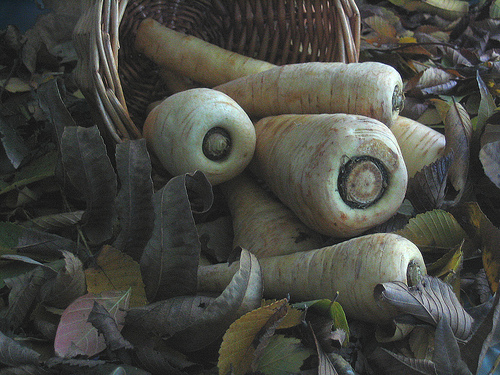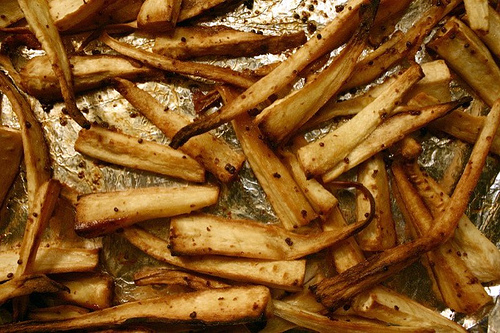
Oh winter vegetables. You grow so tiresome this time of year. Parsnips are one of many winter vegetables which can be baffling to the uninitiated. It's like a big white carrot; what the heck are you supposed to do with that?
Parsnip history
Parsnips are one of the oldest root vegetables in cultivation. They were cultivated by the Romans, and used as a sweetener in Europe before the arrival of cane sugar in the 19th century. Before being properly domesticated, parsnips were dug up and eaten by prehistoric people throughout Europe.
Before potatoes were brought over to Europe from the New World in the 16th century, the parsnip was the main tuber and source of starch in European diets. Much respect to the parsnip, but once potatoes arrived, people went crazy for them, and the parsnip was relegated to the back of the pantry, so to speak.

Image courtesy Flickr/MJaneRoss
Parsnip nutritional information
Parsnips are, like potatoes, mostly starch and water. They are rich in potassium, however, and have a lot of fiber compared to potatoes.
As with potatoes, most of the vitamins and nutrients are concentrated close to the skin of the parsnip, so peeling a parsnip can significantly reduce its nutritional benefits. This is too bad, because parsnips really do need to be peeled before cooking. Ideally you want to just scrape off the thinnest top layer of skin, enough to get the woody bits and stringy roots off, but not enough to actually dig too far into the parsnip's flesh.

Image courtesy Flickr/richard_north
What does a parsnip taste like?
Imagine a potato that tastes like a carrot, and you're getting close. Parsnips also have a sweetness to them, similar to sweet potatoes. Although you can eat parsnips raw, cooking them really brings out the sweetness.
Choosing and storing parsnips
Bigger is not better. Choose parsnips that look good (no black bits or soggy bits), and which are in the middle of the size range in the bin. When parsnips get too big, they get an unpleasantly woody center (similar to very large carrots). You can cut out this woody center when you are prepping the parsnip, but it's better to avoid it altogether by selecting a smaller parsnip.
Parsnips will last several weeks in your crisper if conditions are right. If it's too dry, they may turn leathery after a while. If it's too damp (or they are inside a damp plastic bag) they can rot. But for the most part, parsnips keep well.

Image courtesy Flickr/rdpeyton
What do you do with parsnips?
Basically, anything you can do with either a carrot or a potato, you can do with a parsnip.
The most common way to prepare parsnips is to cut them into cubes and roast them in the oven. Roast parsnip is a classic component of a traditional British and Irish Sunday Roast, along with roast beef and Yorkshire puddings.
Parsnips can also be boiled and mashed up, just like mashed potatoes. And, much like carrots, they add a nice flavor to soups. Cube up the parsnip and toss it into the soup as it's cooking. If you plan to eat the parsnip cubes, add them near the end of the cooking, so they don't get too mushy. If you want the parsnips to help thicken the soup with their starchy goodness, add them at the beginning of the cooking time to give them ample time to break down.

Image courtesy Flickr/jennylaujennylau
Parsnip recipes
Your basic roasted parsnip recipe is pretty simple: cut them up, mix them with oil, salt, and pepper, and roast them in the oven until tender and brown. Here's a brief recipe with all the specs you'll need to create a delicious side dish.
Nigella Lawson's maple-roasted parsnips leverages the parsnip's natural sweetness with a little kick of maple syrup. Sounds delicious!
Here's an interesting spicy take on the traditional roasted parsnips. (If you're not a fan of horseradish, you can always use less of it.)
Looking for something a little more adventurous? Here are some parsnip recipes that go off the beaten path:
- Bon Appetit: Roasted root vegetable salad with mint and pistachios
- Bon Appetit: Roasted parsnip soup with walnut pesto
- Epicurious: Parsnip crisps (chips, for those of us in the United States)
Main image courtesy Flickr/farmanac

1 comments